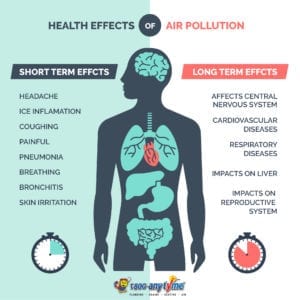Inside Air vs. Outside Air: Which Could Be Worse?
When we think about air quality, we naturally assume that staying indoors would be safer and healthier. But consider your inside air vs. outside air: which could be worse?
COMMON OUTDOOR AIR POLLUTANTS |
|
|
ozone |
particulate matter |
|
nitrogen dioxide |
sulfur dioxide |
|
carbon monoxide |
toxic air pollutants |
|
Source: American Lung Association |
|
The list above looks pretty serious, but do you know what could be in your indoor air?
SOURCES OF INDOOR AIR POLLUTION |
|
|
asbestos |
biological pollutants |
|
carbon monoxide |
formaldehyde/pressed wood products/gases |
|
lead |
nitrogen dioxide |
|
pesticides |
radon |
|
indoor particulate matter |
secondhand smoke/environmental tobacco smoke |
|
stoves/heaters/fireplaces/chimneys/pollutants |
volatile organic compounds |
|
Source: United States Environmental Protection Agency |
|
According to the United States Environmental Protection Agency, more and more evidence is indicating that the air inside of our buildings is more polluted than the air outside. The longer you spend indoors, the more susceptible you are to the effects of indoor air pollution. Some of these effects appear sooner, and some not for years. The fact that you feel healthy now does not mean that you won’t develop symptoms in the future.

Air enters into buildings through leaks, infiltration, natural ventilation, and mechanical ventilation.
- Infiltration: Outdoor air enters buildings through:
- Openings
- Cracks in walls
- Joints
- Floors
- Ceilings
- Around windows and doors
- Natural Ventilation: Air flows through:
- Open windows
- Open doors
- Mechanical Ventilation:
- Outdoor-vented fans for bathrooms and kitchens
- Air handling systems that continuously remove indoor air and distribute filtered and conditioned outdoor air to specific points throughout the house
The Best Solution

There are many different air filtering products on the market. Among the best is the Air Scrubber Plus which uses technology developed for the U.S. space program. Originally designed to prevent premature aging in plants grown by astronauts while on long-term space missions, it was discovered that this invention also killed pathogens. The maker of the Air Scrubber Plus modified this technology by taking the circulated air generated by a building’s heating and cooling ventilation system and produces molecules that disperse into the environment. This effectively kills pathogens in the air and on surfaces. When combined with effective whole-house filtration, this system can result in indoor air quality that vastly exceeds outdoor air quality.
If You Are Concerned
If you are concerned about your inside air, please don’t hesitate to give us a call. 1-800-anytyme would be happy to assist you. Contact us via our contact form or call (760) 477-0072 to speak with a member of our team today!
